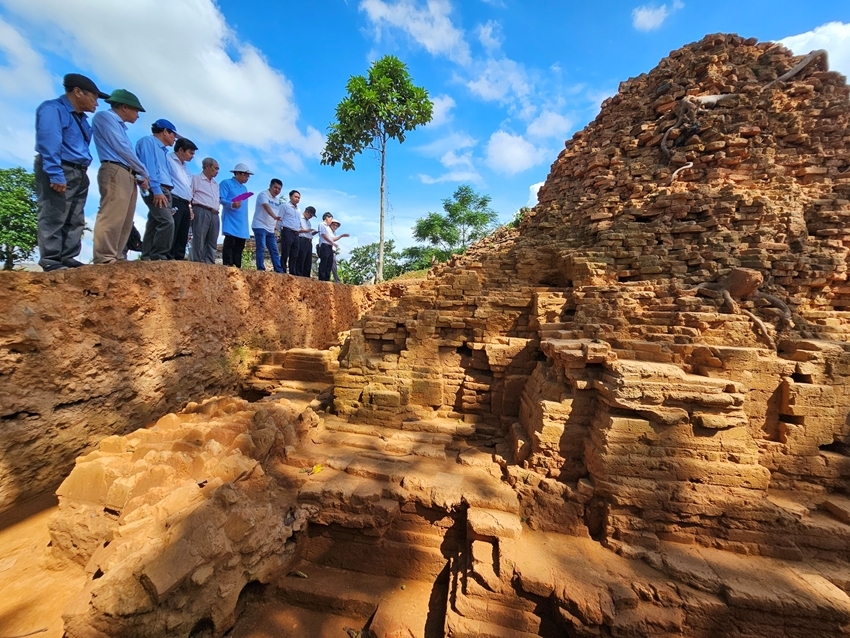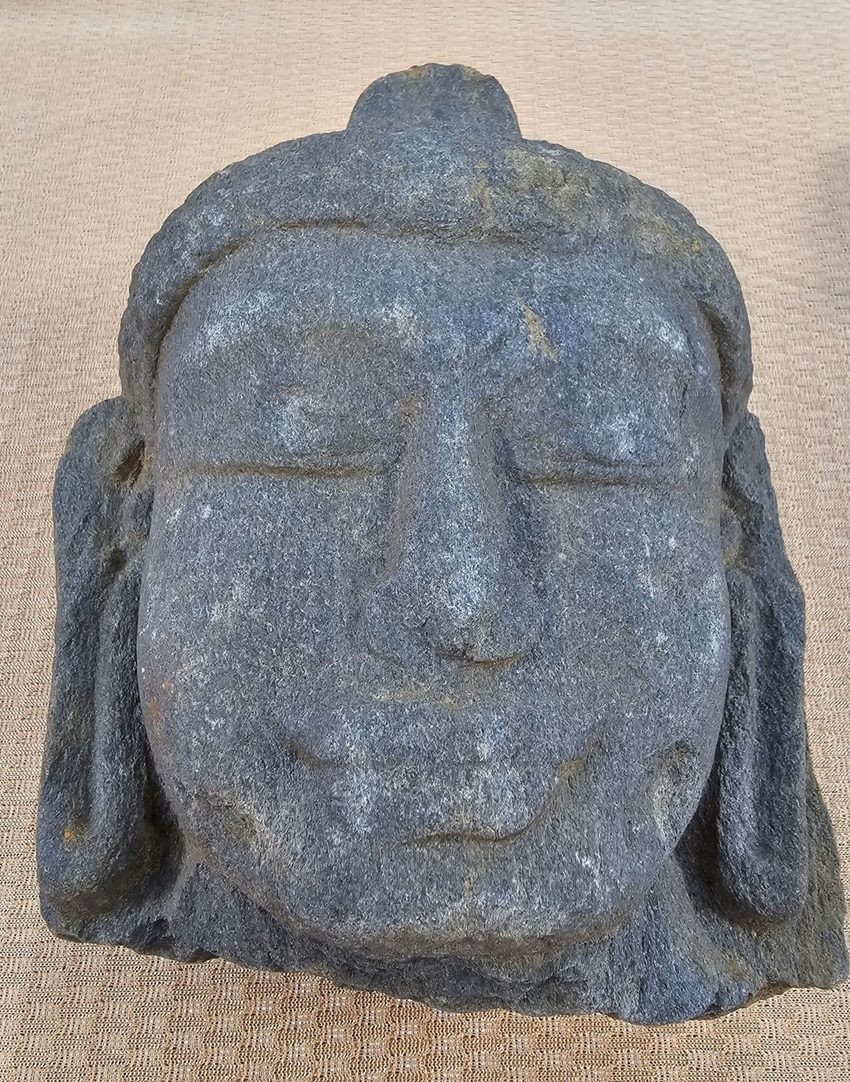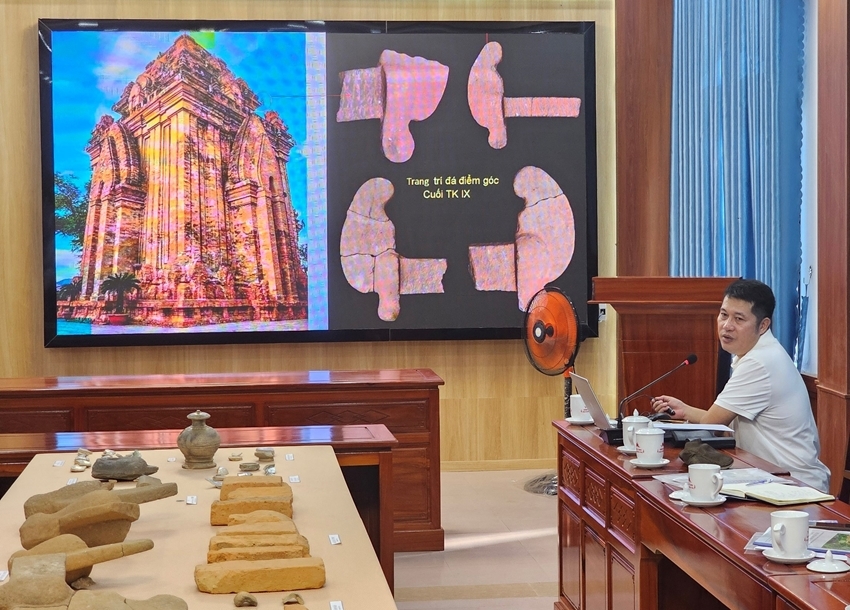 |
| Lieu Coc Twin Towers monument where the archaeological excavations were conducted |
A team of experts from the National Museum of History in collaboration with the Department of Culture and Sports held a meeting to report on the preliminary exploration and excavation of the Lieu Coc Twin Towers monument on the afternoon of June 27 at the Huong Tra Town People's Committee headquarters. Many experts and researchers attended and gave their opinions. Before that, the team also went to the scene for actual observation.
A huge number of relics discovered
Lieu Coc Twin Towers monument is located in Lieu Coc Thuong Village, Bau Thap Hamlet, now Xuan Thap Residential Group (Huong Xuan Ward, Huong Tra Town). Despite the serious degradation and damage, compared to the Champa Tower temples known from Bac My Son (Quang Nam) to the north, besides Phu Dien Tower, Lieu Coc Twin Towers are the monument under the best conservation.
Therefore, the archaeological research and excavation this time are to clearly identify the scale, structure, nature, and age of the monument. This serves the work of planning, preserving, embellishing, and promoting the overall value of the monument with an exploration area of 20m2 (4 holes) and an excavation area of 60m2 (3 holes).
Mr. Nguyen Ngoc Chat, an officer of the National Museum of History, in charge of archaeological exploration and excavation, said that the excavation process expanded and connected the excavation holes (H1, H2, H3) to form a large hole (9.4 x 10.3m), surrounding the architectural foundation of the North Tower. Therefore, the space, scale, and structure of the North Tower temple architecture are clearly identified.
The scale and structure of the North Tower have 4 parts: Foundation, tower base, tower body, and tower roof. The tower's roof alone collapsed and is unrecognizable; the tower body also collapsed more than half, so identification is limited. The foundation and tower body were all built with bricks, staggered horizontally and vertically. The outer and inner coverings of the foundation and tower walls were built all with bricks; only the core of the wall was erected with broken bricks, mixed with yellow clay.
 |
| The Buddha statue was discovered during the archaeological excavation |
In addition, in order to find the location of the path, Gate tower, Fire tower, and boundary wall to go on to expand the research and excavation area to fully determine the scale and structure of the overall surface of the Lieu Coc Twin Towers monument. The experts dug 5 exploration holes, including 2 holes in the east, straight with the central axis of the North Tower, 1 hole in the northeast corner, 1 hole in the southeast corner, and 1 hole in the west.
According to Mr. Chat, along with uncovering the scale of the architectural foundation structure of the North Tower and other related architectural vestiges, during the excavation process, a huge number of relics including more than 4,800 objects were also detected. These objects include primarily architectural materials, architectural decorations, pieces of stelae and stone reliefs, glazed ceramics, porcelain, earthenware, and coins. Notably, the statue's head is in the form of a relief, created on one side from purple-gray slate, symbolizing the Buddha's head with the remaining dimensions of 20cm high, 15cm wide, and 10cm thick. The statue's face is round with half-closed eyes, the high bridge of the nose, the pursed lips, the wide and clear corners of the lips, the long ears, and the twisted hair in a spiral shape was dated from the 11th - 12th centuries. Or one round coin with a square hole, one side embossed with 4 words Nguyen Phong thong bao, written in Hanh Thao style was dated from the 13th century.
“It can be said that this is a collection of precious artifacts. Surely, after being researched, edited, appraised, and scientifically documented, it will provide a lot of important information helpful for research, development, and exhibition to promote value," Mr. Chat acknowledged.
Recommendation to expand the archaeological excavation area
After more than 2 months of excavation with many artifacts and other discoveries, Mr. Chat temporarily dated the construction of Bac Lieu Coc Tower to the late 9th century, corresponding to the date of My Son C2 Tower in the early stage of the Dong Duong art style.
“In addition, when comparing the decorations on the walls of the North Tower with the South Tower in Lieu Coc, we also noticed a difference in the decoration of the columns and wall pillars of these two towers. Most likely, the two towers do not have the same construction date. The data supplementation needs to be continued when there are conditions for researching and expanding the excavation area," Mr. Chat said.
 |
| Mr. Nguyen Ngoc Chat shared information at the preliminary report meeting |
Also at the meeting to report to the Department, Mr. Chat, on behalf of the professional workers, recommended continuing to expand the area of archaeological research and excavation to clearly determine the scale and original structure, nature, characteristics, and date of the Lieu Coc Twin Towers monument. It will serve as a scientific basis for devising a plan to preserve, restore, and promote the value of the monument, and build a dossier on the monument in accordance with its inherent value. It is needed to research and strengthen the tower wall system to prevent degradation, clean brick surfaces, and prevent moss and plants from growing on the architecture. The lower part of the foundation needs to be filled with soil to re-pave the tower yard, leaving only the tower base and tower walls exposed.
In addition, there is a need to research and design the roofed houses for the two main tower architectural works. The prefabricated house can be used with a high dome, surrounded by a system of columns, foundations, and paths around the tower. Simultaneously, modern technology can be used to allow visitors to visualize the complete tower architecture.
Many experts and researchers deemed that although the excavation area of the Lieu Coc Twin Towers this time is not large, it produces vital results. According to researcher Nguyen Xuan Hoa (former Director of the Department of Culture and Information), it is needed to continue to conduct larger-scale excavations while working out the specific solutions to the monument protection.
Mr. Phan Thanh Hai, Director of the Department of Culture and Sports also affirmed that he will propose that the Provincial People's Committee should continue expanding the phase-2 archeology for this monument before this year's rainy season. If this can be done, we will have a basis and plan to preserve and promote the long-term value.
